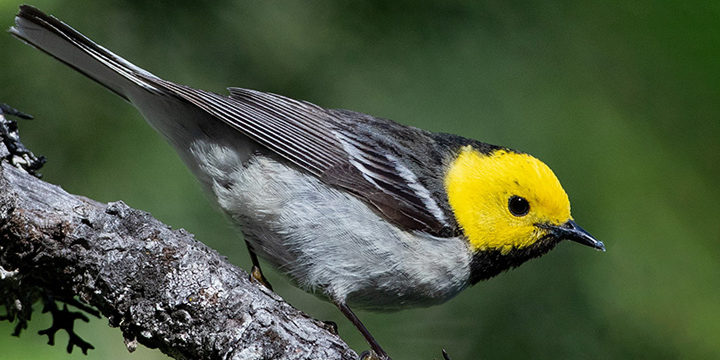Bird of The Week: Hermit Warbler
Scientific Name: Setophaga occidentalis
Population: 2.5 million
Trend: Stable
Habitat: Breeds in western conifer forests; winters in high-altitude pine-oak forests.
About the Hermit Warbler
The Hermit Warbler’s species name, occidentalis, means “of the west” and is based on the bird’s breeding habitat in the coniferous forests of Washington, Oregon, and California. This bright little warbler can be tricky to spot; like the Cerulean Warbler, it spends most of its time in the canopy of the tallest trees. This seeming elusiveness led to the moniker of “hermit,” even though the bird is not particularly shy and may even join mixed-species flocks during migration.
Although unique in appearance, the Hermit Warbler is a member of a larger group of closely related warbler species.
Hazardous Hybridizing
Ornithologists consider the Hermit Warbler to be part of a larger “superspecies” — a group of closely related species that evolved from a common ancestor, but live in largely separate geographic areas. This group includes the Black-throated Green, Townsend’s, and Golden-cheeked Warblers in addition to the Hermit Warbler.
In Washington and Oregon, the Hermit Warbler’s range overlaps with that of its closest relative (known as its “sister” species), the Townsend’s Warbler, where the two hybridize. In these areas, the more aggressive Townsend’s Warbler outcompetes the Hermit Warbler, in much the same way that the Blue-winged Warbler appears to be displacing the Golden-winged Warbler in the East.
Songs and Sounds
The male Hermit Warbler sings a squeaky, high-pitched tune as it forages through the treetops. Both males and females give sharp chip calls.
Breeding and Feeding
The male Hermit Warbler arrives on the breeding grounds first, and proceeds to establish and aggressively defend a territory. Pairs form shortly after the females arrive. Once mated, the female chooses a nest site high in the tree canopy, where she builds a cup nest of needles, twigs, and other vegetation, lined with softer materials. She lays a clutch of four to five eggs, which she incubates alone for about two weeks. Both parents feed the young, which quickly grow and leave the nest in around ten days. Hermit Warbler parents continue to feed their young for several days after fledging.
Like most other Neotropical migrants, including the Prairie Warbler and Blackpoll Warbler, the Hermit Warbler is insectivorous, dining on caterpillars, beetles, and spiders. It forages in the forest canopy, gleaning insects from twigs and flying out to snatch prey in midair.
Males tend to feed higher in the tree canopy than females, a habit also observed in the Red-faced Warbler. Hermit Warblers may even hang upside-down from branches as they probe for prey, resembling extra-bright chickadees.
Region and Range
Although Hermit Warbler populations are thought to be stable, this species has a rather limited distribution. It breeds in mature coniferous forests along the west coast of the U.S., in the Cascade mountains of western Oregon and Washington, and in California’s Sierra Nevada mountains. Like other warblers, it is migratory, traveling south to winter in cool mountain forests of pine and pine-oak and cloud forests in Mexico and Central America. A few winter in areas of the southern California coast.
Conservation of the Hermit Warbler
Advocating for Old-growth Forests
Although still considered fairly common, the Hermit Warbler is vulnerable to habitat loss from the disappearance of northwestern forests throughout its breeding range. ABC continues to advocate for the old-growth forests of the Pacific Northwest that provide breeding habitat for the Hermit Warbler and other declining bird species including the Northern Spotted Owl, Marbled Murrelet, and Varied Thrush. Our BirdScapes approach to conservation also protects important habitat for wintering Hermit Warblers and other Neotropical migrants in Mexico. At El Carricito, established in 1998 with partner Bosque Antiguo, wintering Hermit Warblers share upland pine-oak forests with the Thick-billed Parrot and Military Macaw, plus other Neotropical migrants such as the Western Tanager and Rufous Hummingbird. A project in the Sierra de Atoyac of Guerrero state, Mexico, where Hermit Warblers also winter, protects habitat for the Short-crested Coquette, a Critically Endangered hummingbird.
Get Involved
Policies enacted by the U.S. Congress and federal agencies, such as the U.S. Fish and Wildlife Service, have a huge impact on migratory birds. You can help shape these rules for the better by telling lawmakers to prioritize birds, bird habitat, and bird-friendly measures. To get started, visit ABC’s Action Center.
Living a bird-friendly life can have an immediate impact on migratory birds in the United States. Doing so can be as easy as adding native plants to your garden, avoiding pesticides, and keeping cats indoors. To learn more, visit our Bird-Friendly Life page.
American Bird Conservancy and our Migratory Bird Joint Venture partners have improved conservation management on more than 8.5 million acres of U.S. bird habitat — an area larger than the state of Maryland — over the last ten years. That’s not all: With the help of international partners, we’ve established a network of more than 100 areas of priority bird habitat across the Americas, helping to ensure that birds’ needs are met during all stages of their lifecycles. These are monumental undertakings, requiring the support of many, and you can help by making a gift today.
Source: American Bird Conservatory (abcbirds.org)


